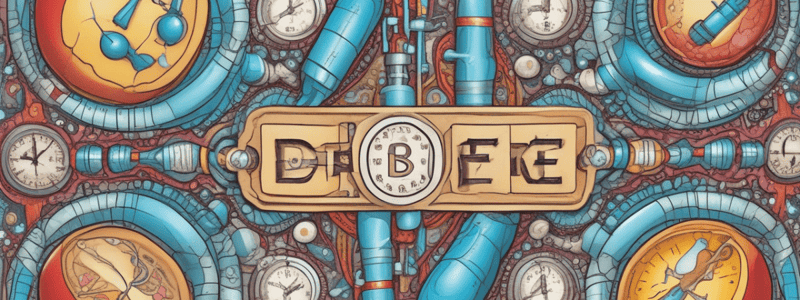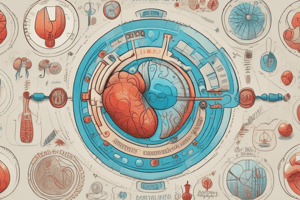Podcast
Questions and Answers
What is the main function of insulin in the body?
What is the main function of insulin in the body?
What is the characteristic of Type 1 diabetes?
What is the characteristic of Type 1 diabetes?
What percentage of people have Type 1 diabetes?
What percentage of people have Type 1 diabetes?
What is the name of the genes associated with Type 1 diabetes?
What is the name of the genes associated with Type 1 diabetes?
Signup and view all the answers
What is the characteristic of Type 2 diabetes?
What is the characteristic of Type 2 diabetes?
Signup and view all the answers
What is the name of the type of diabetes that is characterized by an autoimmune destruction of the insulin-producing beta cells?
What is the name of the type of diabetes that is characterized by an autoimmune destruction of the insulin-producing beta cells?
Signup and view all the answers
What is the percentage of people who have Type 2 diabetes?
What is the percentage of people who have Type 2 diabetes?
Signup and view all the answers
What happens to the pancreas in Type 2 diabetes?
What happens to the pancreas in Type 2 diabetes?
Signup and view all the answers
What is the primary cause of Type 1 diabetes?
What is the primary cause of Type 1 diabetes?
Signup and view all the answers
Which of the following is a characteristic of Type 2 diabetes?
Which of the following is a characteristic of Type 2 diabetes?
Signup and view all the answers
What is the purpose of a blood test for antibodies in diagnosing diabetes?
What is the purpose of a blood test for antibodies in diagnosing diabetes?
Signup and view all the answers
What is the result of a fasting blood sugar level of 100-125 mg/dL?
What is the result of a fasting blood sugar level of 100-125 mg/dL?
Signup and view all the answers
What is HNF1A MODY?
What is HNF1A MODY?
Signup and view all the answers
What is the treatment for Type 1 diabetes?
What is the treatment for Type 1 diabetes?
Signup and view all the answers
What is the result of a fasting blood sugar level of 126 mg/dL or higher on two separate tests?
What is the result of a fasting blood sugar level of 126 mg/dL or higher on two separate tests?
Signup and view all the answers
What is the primary difference between Type 1 and Type 2 diabetes?
What is the primary difference between Type 1 and Type 2 diabetes?
Signup and view all the answers
What is the primary function of hemoglobin in red blood cells?
What is the primary function of hemoglobin in red blood cells?
Signup and view all the answers
What is the first step to take when treating a patient with low blood sugar?
What is the first step to take when treating a patient with low blood sugar?
Signup and view all the answers
What is the recommended amount of fast-acting carbohydrates to administer to a patient with low blood sugar?
What is the recommended amount of fast-acting carbohydrates to administer to a patient with low blood sugar?
Signup and view all the answers
What is the purpose of the A1C test?
What is the purpose of the A1C test?
Signup and view all the answers
What should you do if the patient is unconscious or unable to swallow?
What should you do if the patient is unconscious or unable to swallow?
Signup and view all the answers
What is a common oral manifestation of diabetes?
What is a common oral manifestation of diabetes?
Signup and view all the answers
How can diabetes affect the gums?
How can diabetes affect the gums?
Signup and view all the answers
After the patient's blood glucose level stabilizes, what should you provide to maintain blood sugar levels?
After the patient's blood glucose level stabilizes, what should you provide to maintain blood sugar levels?
Signup and view all the answers
How often should you recheck the blood glucose level after administering fast-acting carbohydrates?
How often should you recheck the blood glucose level after administering fast-acting carbohydrates?
Signup and view all the answers
What is the recommended treatment for dry mouth caused by diabetes?
What is the recommended treatment for dry mouth caused by diabetes?
Signup and view all the answers
What should you do if the patient's blood glucose level remains low after administering fast-acting carbohydrates?
What should you do if the patient's blood glucose level remains low after administering fast-acting carbohydrates?
Signup and view all the answers
What is a complication of gum disease in severe cases?
What is a complication of gum disease in severe cases?
Signup and view all the answers
What is the recommended way to manage type 1 diabetes?
What is the recommended way to manage type 1 diabetes?
Signup and view all the answers
What is the purpose of self-monitoring in type 1 diabetes?
What is the purpose of self-monitoring in type 1 diabetes?
Signup and view all the answers
What can promote the growth of fungi in the mouth of a diabetic patient?
What can promote the growth of fungi in the mouth of a diabetic patient?
Signup and view all the answers
What is a common sign of thrush in a diabetic patient?
What is a common sign of thrush in a diabetic patient?
Signup and view all the answers
Why do cuts or surgeries in the mouth of a diabetic patient heal slower?
Why do cuts or surgeries in the mouth of a diabetic patient heal slower?
Signup and view all the answers
What is a sign of Burning Mouth Syndrome in a diabetic patient?
What is a sign of Burning Mouth Syndrome in a diabetic patient?
Signup and view all the answers
What is a guideline for managing a diabetic patient in the dental office?
What is a guideline for managing a diabetic patient in the dental office?
Signup and view all the answers
What should be done immediately if a diabetic patient is severely hyperglycemic?
What should be done immediately if a diabetic patient is severely hyperglycemic?
Signup and view all the answers
What should be done first if a diabetic patient is hypoglycemic?
What should be done first if a diabetic patient is hypoglycemic?
Signup and view all the answers
Why should the patient's vital signs be monitored while waiting for EMS?
Why should the patient's vital signs be monitored while waiting for EMS?
Signup and view all the answers
Study Notes
Diabetes Mellitus
- A chronic health condition that affects how the body turns food into energy.
- The body breaks down most food into sugar (glucose), releasing it into the bloodstream.
- When blood sugar levels rise, it signals the pancreas to release insulin, which acts as a key to let blood sugar into the body's cells for energy.
Type 1 Diabetes
- Also known as juvenile diabetes, usually diagnosed in children and young adults.
- Only 5% of people have this disease, characterized by an autoimmune destruction of the insulin-producing beta cells in the pancreas.
- Individuals with type 1 diabetes produce little to no insulin, requiring insulin injections to manage blood sugar levels.
- Insulin resistance is not a defining feature of type 1 diabetes.
- The disease involves multiple genes, each contributing a small amount to the overall risk (polygenic).
- The strongest genetic associations are with the human leukocyte antigen (HLA) region on chromosome 6, particularly HLA-DR3 and HLA-DR4 alleles.
Type 2 Diabetes
- The most common form of diabetes (about 90% of cases).
- The body produces insulin, but does not use it properly.
- In type 2 diabetes, the body's cells become resistant to the effects of insulin.
- Initially, the pancreas compensates by producing more insulin, but over time, it cannot keep up, leading to elevated blood sugar levels.
- Insulin resistance is a key characteristic of type 2 diabetes.
- Exposure to viruses and other environmental factors may contribute to the development of type 2 diabetes.
Causes and Risk Factors
- Weight and age
- Fat distribution
- Physical inactivity
- Family history
- Blood lipid levels
- Prediabetes
- Polycystic ovaries
Diagnosis
- A blood sample is taken after an 8-hour fast to determine blood sugar levels.
- A fasting blood sugar level less than 100 mg/dL is healthy.
- A fasting blood sugar level from 100 to 125 mg/dL is considered prediabetes.
- A level of 126 mg/dL or higher on two separate tests indicates diabetes.
- A blood test for antibodies is used to distinguish between type 1 and type 2 diabetes.
- The A1C test is a cumulative sugar test that provides information about average blood glucose levels over the past 3 months.
Managing Type 1 Diabetes
- Self-monitoring: patients with type 1 diabetes should learn to record their blood glucose levels.
- Lifelong insulin therapy: managed by taking insulin injections.
Managing Type 2 Diabetes
- Maintain an ideal diet and exercise.
- Use of metformin as the optimal first-line drug unless contraindicated.
- Ultimately, insulin therapy alone or with other agents may be needed to maintain blood glucose control.
Oral Manifestations
- Dry mouth (xerostomia)
- Tooth decay and root caries
- Altered taste
- Thrush
- Gingivitis and periodontal disease
- Burning sensation
- Ulcers
- Gum disease: diabetes can make gums more prone to infections.
- Dry mouth: diabetes can reduce saliva production, leading to more cavities and mouth sores.
- Thrush: high blood sugar can promote the growth of fungi in the mouth.
- Slow healing: cuts or surgeries in the mouth may heal slower and get infected more easily.
- Burning mouth syndrome: signs include a burning sensation in the mouth.
Dental Management
- Guidelines for managing a diabetic patient in the dental office:
- Comprehensive medical history
- Scheduling morning appointments
- Blood glucose monitoring
- Stress management
- Managing xerostomia
- Caries prevention
- Post-operative care
- Emergency treatment
Emergency Management
- Hyperglycemia:
- Assess the patient's blood glucose level and signs of diabetic ketoacidosis (DKA) or hyperosmolar hyperglycemic state (HHS).
- Stop any dental procedure immediately.
- Ensure the patient is hydrated and comfortable.
- Seek medical assistance if necessary.
- Hypoglycemia:
- Assess the patient's blood glucose level and signs of hypoglycemia.
- Stop any dental procedure immediately.
- Have the patient sit or lie down to prevent falls or injuries.
- Administer fast-acting carbohydrates if the patient is conscious and able to swallow.
- Recheck the blood glucose level after 15 minutes and repeat carbohydrate administration if necessary.
- Call emergency medical services (EMS) if the patient is unconscious or unable to swallow.
Studying That Suits You
Use AI to generate personalized quizzes and flashcards to suit your learning preferences.
Related Documents
Description
This quiz covers the basics of diabetes, a chronic health condition that affects how the body turns food into energy. Learn about the role of insulin and how it regulates blood sugar levels.




